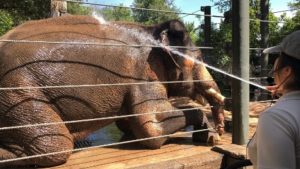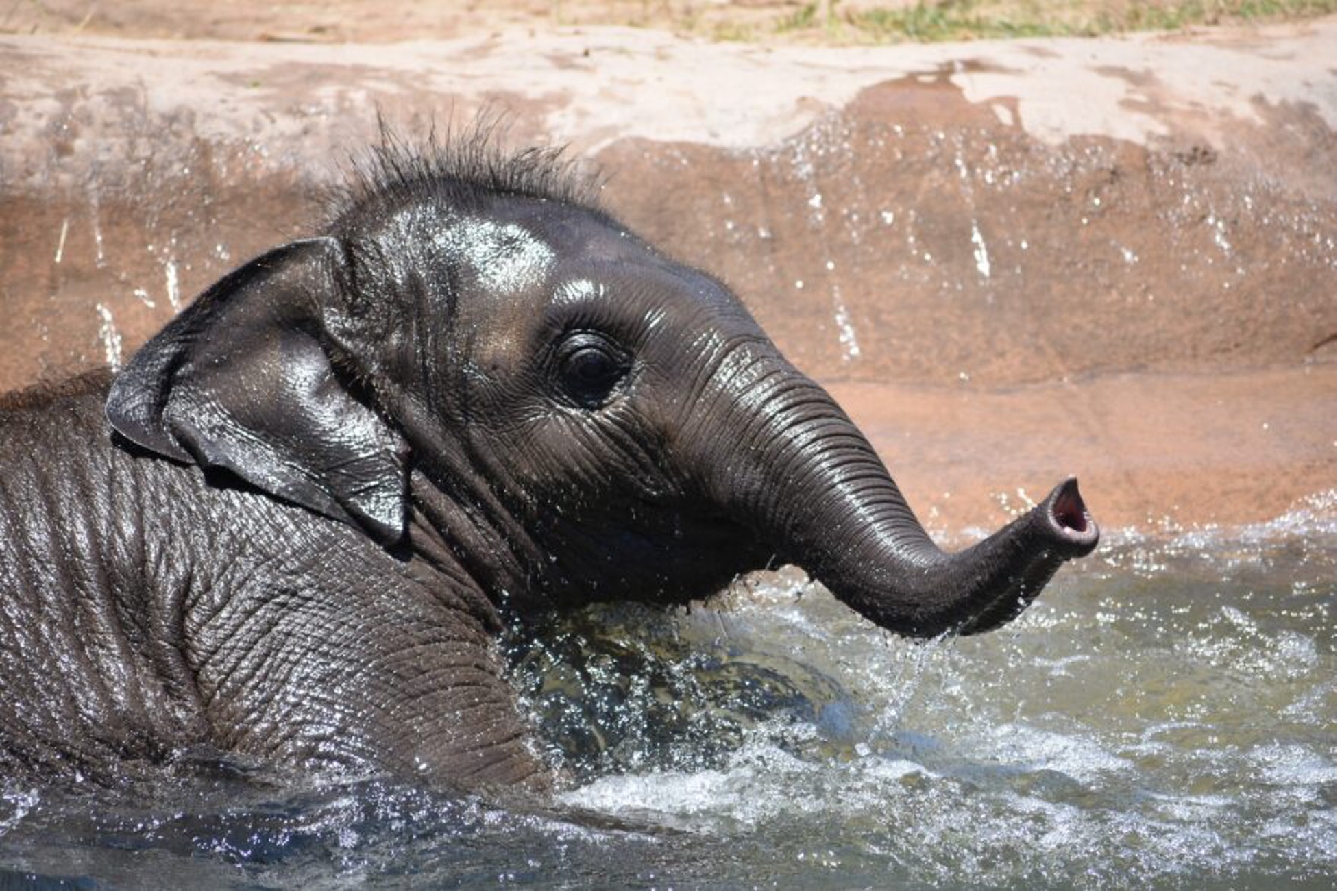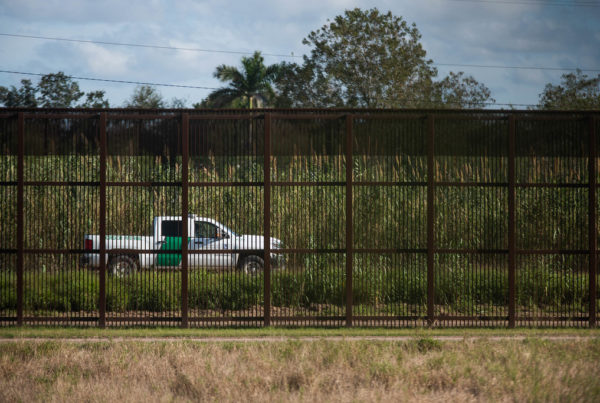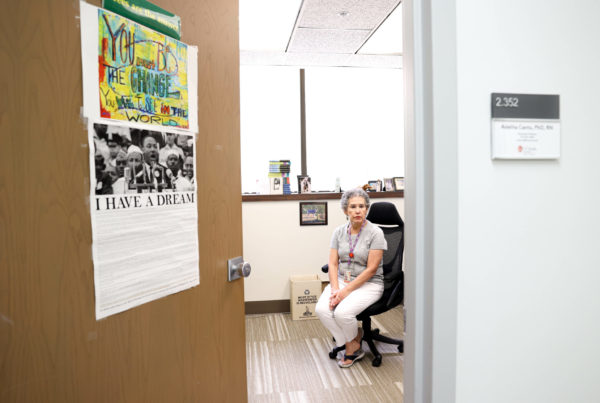Rain or shine, searing heat or freezing temperatures, it’s all hands on deck at the zoo when severe weather strikes.
On a hot and humid day at the Fort Worth Zoo not long ago, groups of preschoolers rush in. It’s peak hours. The children are holding their parents’ hands and their grins are ear to ear. They’re ready to see the animals from their picture books up close.
They don’t get too far in before their parents stop them to apply more sunscreen to their faces, and the children start asking for ice cream.
They aren’t the only ones trying to cope with the blazing heat. A family of elephants flap their ears to cool down.
Adria Cuellar, a zookeeper at the Fort Worth Zoo, is rinsing Colonel, a 31-year-old elephant, to keep him cool.
She said these daily showers encourage the elephants to trust their instincts. Elephants get wet and go play in the mud. Cuellar said the mud helps elephants stay cool.
“I always say it’s their sunscreen and insect repellent,” Cuellar said. “They like the way the cool fan feels on their body. We bring them in every morning and take off the top layer dirt, and we wanna make sure that nothing would have happened overnight.”
Avery Elander, director of marketing and public relations at Fort Worth Zoo, said living spaces at the zoo mirror the environments that animals would face in the wild.
“As we’re designing and redesigning the zoo, and creating new habitats, we’re able to plan for some of these measures,” Elander said.
“When we built Elephant Springs, we added permanent shade structures because we knew it was going to be warm during the summer and they might want to have that respite when they’re out in their outdoor habitats.”
Elander said elephants have shaded areas, large outdoor pools and resting spaces — all measures to help animals beat extreme weather.
Some animals at the zoo have been living there for decades.
When temperatures soar, zoologists observe animals daily for signs of over-exhaustion. They look for open mouths and panting. And they track animals’ urination and hydration schedule every few hours.
The zoo currently houses eight elephants from three generations, from 50-year-old Rasha to 10-month-old Brazos.
Reptiles and amphibians are located indoors in the Museum of Living Art because they have to live under separated and strictly regulated temperatures and humidity.
Elander said the Fort Worth Zoo anticipates warmer weather every year and keeps any extra expenses in mind for the budget — whether it is for extra ice or extra cooling devices.
The Dallas Zoo has animals from hot climates — including those native to the Sahara Desert. Even for them, summer in Texas can be brutal. And when cold weather hits, animals who are adapted to high temperatures have a tougher time.

Colonel the 31-year-old elephant gets his daily rinse by zookeeper Adria Cuellar. Daily showers are a way for zookeepers to inspect the animals’ skins, cool them down and encourage them to roll in the mud to create a natural sunscreen.
Yaamini Jois / KERA
Kari Streiber with the Dallas Zoo said nutritionists have come up with fun treats to cool down animals when it’s hot.
Zoologists freeze fruits and veggies for herbivores such as hippos. But carnivores — like big cats — need to munch on more than a veggie salad. And there’s an appetizing treat — appetizing, at least, for them.
“The zoologists call them bloodiscles,” Streiber said. “It typically is a treat that they would normally get, and they’ll either freeze the meat or freeze the blood.”
However, it’s not just frozen treats. Ice beds are made for animals that prefer to lounge on a cool surface. Zoos also have circulation water systems. This helps the water stay cool and fresh. And the zoo has installed more fans, portable AC units.
From extreme heat to freezing temperatures
The heat is one challenge. As colder weather creeps in, Streiber said zoos prepare to deal with another kind of extreme weather.
“It’s sort of the opposite of the preparation for the heat,” Streiber said. “That’s when you’re bringing in additional heaters and generators to make sure you keep the power on across the zoo, and to make sure the heating is all in place.”
Other preparations include regulating pool temperatures to stay warm in colder weather.
Zookeeper Megan Sypert works with giraffes, which are more sensitive to colder weather.
“They have a threshold of about 45 degrees, and if it’s under that, they stay in the barn with their heaters,” Sypert said. “They really don’t like the cold.”
If a sudden storm were to occur, outdoor animals will seek shelter from their designated spot within the living space. They’re trained to respond to zookeepers and quickly go back inside before the weather gets worse.
“If there is a chance of storms, the zoologists are very well aware of what the procedures are to call animals back off-habitat,” Streiber said. “That’s training that happens with the animals ongoing — it’s a form of recall training.”
While staff at the Fort Worth Zoo are there every day, it’s all hands on deck on days where severe weather is expected. Precautions at the Fort Worth Zoo start days in advance once news of winter storms hit. Staff work to prepare food deliveries and extra materials for animals.
Elander said that some staff will even spend the night at the zoo to help prepare the zoo for harsher weather.
Zoo staff said they are already bracing themselves and have started preparing for the cold months ahead.














